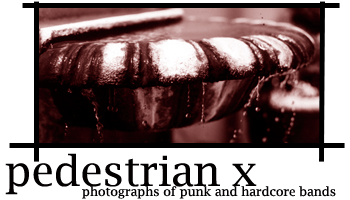

Photographing Bands > Part Four
Part Four: Film ( July 28, 2000 )
So, you have your camera, your flash, your lens and you're ready to go. The natural next step is, what kind of film am I going to use??? Well, there is the natural question, Color or Black and White!??! I'll start off by saying what I think you should consider before choosing which to photograph with ( not that you have to make an exclusive choice, by any means).
Color Vs. Black and White Film
There are significant differences in photographing with each of these films. I find that black and white photographs offer less distraction from the subject than color photographs. Backgrounds in color photos can often be colorful, thus distracting the focus of the image from the subject. Blah blah blah. I prefer photographing in black and white by far, hence 90% of my photos are in B&W. It is possible to have a normal, straight up high contrast b&w photo of a band that looks killer, but it's much harder to pull off with color film. Overexposure, where the light hitting the subject is too intense, and detail is washed out, tends to have a much more negative affect on a color photo than on a b&w one. So, my preference is to photograph mostly in black and white.
Black and White Film
So, you may already realize that processing black and white film costs much more, and takes longer. Don't despair, there are at least 3 types of films that can be developed by the normal color process and turn out black and white. I know Ilford produces one of these films, and Kodak has 2, the T400CN and Black and White+. Both are 400 speed films, but there are differences between the 2. The T400CN film had problems of color tones in the print when printed on color paper, so Kodak came out with Black and White+, which doesn't have as many problems with color tones. Basically what happens is that you get a duotone image. A Black and White image is duotone image, with the two tones being black and white, but with the color tones sometimes you'd get a duotone image with Aqua and Black tones. It looks kind of cool, but I find it mostly a pain in the ass. 90% of my photos have been taken with the T400CN film, or the Black and White+ film.
And if you want to get standard black and white film, and develop it yourself, or pay the extra for developing, then go for it, you'll have better prints.
Color Film
There aren't many options here, just pick a film that you feel is right for you. I've used different things, from Kodak Max, to Fuji film. I understand that Kodak Royal Gold is pretty cool, but I haven't tried it out yet.
Film Speeds
The speed of your film is pretty important. The slower the film, i.e. the less sensitive it is to light, the lower the number. So, 100 is a pretty slow film. I find that usually for standard photos, I choose a 400 ISO Film. However, if you want to do some cool stuff, and have some grainy photos, I'd pick a 3200 ISO Black and White film. There are other things you can do with fast films, such as 1600 ISO, with long exposures, that saturates the image with color streaks. It isn't necessary to have a fast film for color streaks, or any streaking, but the faster the film, the more the long exposure will add to the photo. So yeah, I usually pick a standard 400 ISO film.
|
The Ataris - Kodak Black and White+ 400 ISO Film |
Stretch Armstrong - Kodak TMAX 3200 ISO Film |
|
Trial - Kodak Max 800 ISO Film |
One King Down - Fuji 1600 ISO Color Film |